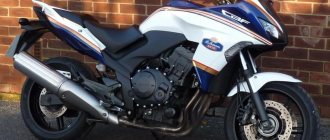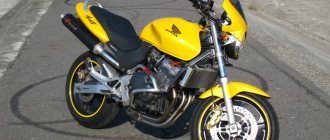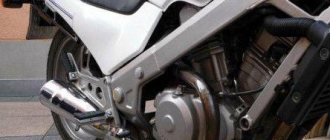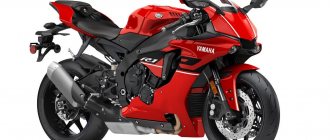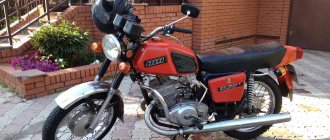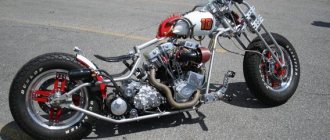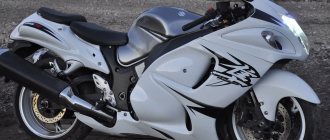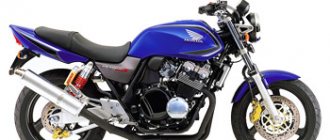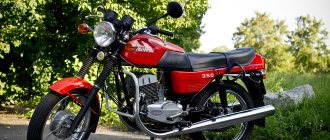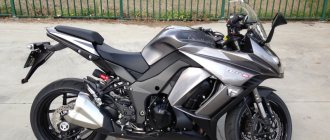This model of the legendary classic motorcycle began its history in 1992. The predecessor to the CB 400 was the Honda CB-1. The main feature of the CB 400 SF was the engine, which, despite its small volume of 399 cm3, turned out to be the most reliable among its Japanese counterparts.
The motorcycle was created for the Japanese domestic market and designed for beginner motorcyclists: according to current rules, the engine capacity should not exceed 400 cm3 and the power should not exceed 53 hp. The Super Four's reputation as a simple and reliable motorcycle made it the first motorcycle of choice not only in Japan but throughout the world.
Specifications
| Model | Honda CB 400 Super Bold'or NC42 |
| Motorcycle type | Road, street, naked |
| Frame | Duplex two-pipe welded |
| Acceleration 0-100 km/h | 4.5 sec |
| Maximum speed | 180 km/h (limiter) |
| Turning radius | 2.6 m |
| Passenger capacity | Driver and passenger |
| Motorcycle weight | 200 kg |
Engine
| Type | Inline 4-stroke, 4-cylinder, liquid cooled, DOHC 4 valves per cylinder |
| Model | NC42E |
| Working volume | 399 cm3 |
| Cylinder diameter | 55 mm |
| Piston stroke | 42 mm |
| Compression ratio | 11,3:1 |
| Maximum power | 38 kW / 53 hp at 10,500 rpm |
| Maximum torque | 38 Nm / 3.9 kgm at 9,500 rpm |
| Injection | Electronic PGM-FI system |
| Ignition | Electronic, electric starter |
| Idle speed | 1400 +- 100 rpm |
| Valve clearances (at engine temperatures below 35 degrees) | Inlet: 0.20 mm Exhaust: 0.27 mm |
Transmission
| Clutch type | Multi-disc in oil bath, cable drive |
| Transmission | 6-speed |
| Final drive ratio | 2,171 |
| Gearbox ratios | 1st gear: 3.307 2nd gear: 2.294 3rd gear: 1.750 4th gear: 1.421 5th gear: 1.240 6th gear: 1.130 |
| Drive chain ratio | 2,933 |
Suspension and tires
| Front suspension | Telescopic fork with 120 mm travel |
| Rear suspension | dual shock absorber with preload adjustment and 110 mm travel |
| Front tire size | 120/60ZR17M/C 55W |
| Rear tire size | 160/60ZR17M/C 69W |
| Front brakes | 2 discs 296 mm, 4-piston caliper |
| Rear brakes | 1 disc 240 mm, 2-piston caliper |
Dimensions
| Honda CB400 Super Four (CB400/A) | Honda CB400 Super Bold'or (CB400SA) | |
| total length | 2040 mm | |
| Overall Width | 725 mm | |
| Overall height | 1070 mm | 1155 mm |
| Wheelbase | 1410 mm | |
| Ground clearance | 130 mm |
Fuel consumption
The rated fuel consumption at a speed of 60 km/h is 3.25 liters per 100 km.
Practical consumption greatly depends on driving style. For a quiet ride this is 4-5 liters. For dynamic driving - up to 8 liters.
Honda SB 400: model history
As mentioned earlier, the production and development of the CB400 series began in 1975, and the first-born was the CB400F. 14 years later, in 1989, it was replaced by the legendary CB-1, and 2 years later the CB-1 Type 2 was born. Officially, the motorcycle was only supplied to Japan and the USA.
Finally, in 1992, Honda released the CB400 Super Four F2N on an updated NC31 frame. Officially, this motorcycle was sold only within the Japanese market. All other countries sold it “in gray”.
In 1995, Honda released the R (Racing) version: it received fairings and a rectangular headlight instead of the traditional round one. In 1996, the S (Sport) version was released. It differed from the R version in the classic round headlight, and the red zone on the tachometer moved to 13,000 rpm.
This allowed the company to create carburetors with greater performance. The passenger footpegs have been modified, and the motorcycle has lost its central stand.
Early modifications were supplied with the NISSIN brake system, and then it was changed to BREMBO with larger diameter brake discs. The S and R versions featured the same exhaust systems as the CBR400RR of the same production period.
In 1999, at an exhibition in Tokyo, Honda presented a completely new model, the CB400 Super Four Hyper Vtec Spec 1. Honda’s proprietary Vtec system appeared for the first time on 400 engines. The design has also been changed.
The frame was marked NC39. In 2002, another modification, CB 400 Super Four Hyper Vtec Spec 2, was released, and in 2003, Spec 3.
The differences between the versions were in the Vtec system - it worked at different speeds. The design of the motorcycle was also changed: a headlight with a multi-reflector at the front, a “lantern” with diodes instead of conventional lamps at the rear, a “sharp tail”, and diamond-shaped direction indicators. The gear ratios of the gearbox and final drive have been changed.
In 2005, the HondaCB400 Super Four BOLDOR version appeared. It added a fairing and an adjustable fork. Since 2008 to this day, the REVO version has been produced.
Being a purely road bike, the CB400 did not take part in large-scale racing - WSBK bypassed it. However, in smaller events, the CB400 often becomes a true friend of motorcyclists.
For example, like the Japanese racer Takehiro Tsutsui in the DOBAR race in May: the motorcycle was used in almost completely stock configuration, but, of course, it could not be done without modifications: the car received a Keihin FCR33 kit, a larger radiator and new reinforced rear shock absorbers from Öhlins .
DOBAR races are always held at the Tsukuba Circuit, and have categories depending on the driver's age, class, power and engine size of his motorcycle. Takehiro participated in the DOBAR race in the Zero4 class, where a variety of motorcycles have been seen at the start for more than 20 years: 4-stroke machines with a 400 cc engine and 250 cc two-stroke engines.
Needless to say, the Honda CB400 and first place on the podium were inextricably linked?
Do you know that another Japanese motorcycle, Yamaha R1, has a maximum speed of 300 km/h! You can view the full technical specifications in our article.
Another very interesting motorcycle from the land of the rising sun in our article:
Owner reviews
A motorcycle with excellent driving characteristics. A wonderful motorcycle to replace the new Chinese one!
It is not fussy about maintenance; after purchase you need to replace the pads, chain, sprockets, and then you need to regularly change the oils and filters. I recommend filling gasoline above the required octane number, this makes the motorcycle ride more fun and eat less - but why? Because the gasoline is of poor quality!
Any beginner and even a girl can ride a motorcycle. Up front, two huge brake discs allow you to slow down in any situation! If you are not a teenager weighing 50-60 kg, the fork may seem too soft, but this is easily solved by changing the oil with a higher viscosity! It has a simply gorgeous sound with a straight-through pipe.
Nember-11, review on otzovik.com, 2021, motorcycle 1996 https://otzovik.com/review_5908596.html
It’s not for nothing that many people say that this motorcycle is a legend, and it is. Its market price and reliability make it a leader among other motorcycles of the 1990s and early 2000s generation. Dynamics, excellent acceleration, convenient maneuvering in traffic jams are what make it a leader on the road.
And of course, I would like to say about its legendary reliability!
I purchased this motorcycle in 2021 and during this period of use I only changed consumables and filled up with gasoline.
Of course, it has some problems, just like any motorcycle does. For example, a Honda cb 400 has a fork leaking, but I also classify this as a consumable. I advise you to immediately buy guides, oil seals and boots when purchasing such a motorcycle, their replacement is inevitable.
But no other breakdowns occurred during use.
In general, if you are thinking about which motorcycle to buy first, or have decided to switch from a Chinese to a Japanese one, then my advice: take a Honda, you won’t regret it! :)
Maxik-, review on otzovik.com, 2021, motorcycle 1997 https://otzovik.com/review_10158330.html
A good bike for short people, for riding around the city or for beginners. It steers well, forgives many mistakes, is small in size and relatively light. Consumables and spare parts can be found without problems, and their cost is low. “Perpetual” engine, the price does not fall. I noted the dynamism as a minus, but even then, within the framework of its characteristics, it is quite dynamic. I rode it from Moscow to Yaroslavl, Kazan. No complaints, convenient. Tall people will most likely not be very comfortable on it. Faithful, unpretentious iron bunk.
Anna, review on auto.ru, 2021 https://auto.ru/review/moto/motorcycle/honda/cb_400/6383252146198786491/
A very classic and ordinary model. Many may find it boring. But it is definitely more fun than others, even modern four hundred. Acceleration and top speed are steeper than modern competitors (with the exception of the more recent one). Due to the difference in characteristics from the new four hundred, it will last more than a season. Many will be frightened by the lack of abs, but this is more a question of the quality of learning to control a motorcycle, because abs will help you avoid falling, but it is not always effective in braking. Also, due to the age of the model, her light is rather weak. In general, Dovtek Sibishki are as simple as the corner of a house and reliable, adjusted for age. The only thing is that before buying you need to check the moped and get to know the owner - someone blows away the dust, someone hits it, someone drops it, the condition will vary depending on all of this. So if you are not stubborn about abs and LED lights (which are expensive to repair), then this is just a super moped for a beginner to understand what he wants. Well, some remain on the Sibishkas, simply switching to a larger cubic capacity.
Roman, review on auto.ru, 2021 https://auto.ru/review/moto/motorcycle/honda/cb_400/5787769530753981258/
Photo gallery
As stated earlier, the Honda CB 400 motorcycle was released in 1975. Over the years, the appearance has changed several times. Looking at the first models and the more modern ones, it’s hard to say with confidence that this is the same motorcycle model. We bring to your attention a small selection of photos of Honda SB 400 from different years of production.
Determining the year of manufacture by frame number
| Model | Years of manufacture | Frame number |
| CB400SF 2N | 1992 | NC31: 1000001-1034643 |
| CB400SF 2R | 1993 | NC31: 1200001-1212250 |
| CB400SF 2S | 1994 | NC31: 1300001-1307373 |
| CB400SF 3S | 1995 | NC31: 1350001-1354811 |
| CB400SF 2T | 1996 | NC31: 1400001-1401880 |
| CB400SF 3T | 1996-1997 | NC31: 1450001-1456784 |
| CB400SF 2V | 1997 | NC31: 1500001-… |
| CB400SF 3V | 1997-1998 | NC31: 1550001-… |
| CB400SF Fx | 1999 | NC39: 1000001-1007220 |
| CB400SF | 2000 | NC39: 1010001-1019999 |
| CB400SF F1 | 2001 | NC39: 1020001-1029999 |
| CB400SF F2 | 2002 | NC39: 1030001-1039999 |
| CB400SF F3 | 2003 | NC39: 1040001-1049999 |
| CB400SF F4 | 2004 | NC39: 1050001-1099999 |
| CB4005, CB400S5 | 2005 | NC39: 1100001-… |
| CB4006, CB400S6 | 2006 | NC39: 1200001-… |
| CB4007 | 2007 | NC39: 1300001-… |
| CB4008, CB400S8, CB400A8, CB400SA8 | 2008 | NC42: 100001-… |
| CB4009, CB400S9, CB400A9, CB400SA9 | 2009 | NC42: 110001-119999 |
| CB400A, CB400SA, CB400Aa, CB400SAa | 2010 | NC42: 120001-129999 |
| CB400B, CB400SB, CB400Ab, CB400SAb | 2011 | NC42: 130001-139999 |
| CB400C, CB400SC, CB400Ac, CB400SAc | 2012 | NC42: 140001-149999 |
| CB400D, CB400SD, CB400Ad, CB400SAd | 2013 | NC42: 150001-159999 |
| CB400E, CB400AE, CB400SE, CB400SAE | 2014 | NC42: 160001-169999 |
| CB400AF, CB400SAF | 2015 | NC42: 170001-179999 |
| CB400G, CB400AG, CB400SG, CB400SAG | 2016 | NC42: 180001-189999 |
First generation: NC31.
1992-1998 – during this period, motorcycles were practically no different from each other. New configurations appeared: Version R (featuring a built-in plastic fairing and a square headlight) and Version S (featuring a classic round headlight, sporty carburetor settings, lack of a center stand, and 4-piston front calipers).
1992: Model: Honda CB400SF (Super Four); Frame number: NC31-100001 to NC31-1034643; Model code: CB400F IIn
1993: Model: Honda CB400SF (Super Four); Frame number: NC31-120001 to NC31-1212250; Model code: CB400F IIr
1994: Model: Honda CB400SF (Super Four); Frame number: NC31-130001 to NC31-1307373; Model code: CB400F IIs
1995: Model: Honda CB400SF (Super Four) Version R; Frame number: NC31-135001 to NC31-1354811; Model code: CB400F IIIs
1996: Model: Honda CB400SF (Super Four); Frame number: NC31-140001 to NC31-1401880; Model code: CB400F IIt
1996-1997: Model: Honda CB400SF (Super Four) Version S; Frame number: NC31-145001 to NC31-1456784; Model code: CB400F IIIt
1997: Model: Honda CB400SF (Super Four); Frame number: NC31-150000~; Model code: CB400F IIv
1997-1998: Model: Honda CB400SF (Super Four) Version S; Frame number: NC31-155000~; Model code: CB400F IIIv
Service
Consumables
| Battery | Yuasa YTX9BS |
| Oil filter | HM 15410-MM9-PO1 (Honda) HIF HF303 (HI-Flo Filters) |
| Air filter | HM MY9K1 (Honda) Champion J301 HFA 1402 (Hi-Flo Filters) |
| Front tire | Bridgestone BT 45 |
| Rear tire | Bridgestone BT 45 |
| Brake fluid | DOT 4 |
| Front brake pads | FA142 - Kevlar (EBC Brakes) FA142HH - Grooved (EBC Brakes) BB-H030 (Brembo) Sport Compound BB-H030RR (Brembo) Racing Compound FD-B570SS (Ferodo) Supersport 2р-202 (Nissin) FD-B533P(Ferodo)- for CB400SF from '96 (CBR900RR). VD-156 (Vesrah) p188 (Premier) SBS 627 MCB 598 (Lucas) |
| Rear brake pads | BB-H027 (Brembo) Sport Compound BB-H027RR (Brembo) Racing Compound FERODO FDB531 599/599LF (Lucas) 2p-204 (Nissin) |
| Front right disc | FA1132RS (EBC Brakes) |
| Front left disc | FA1132LS (EBC Brakes) |
| Front brake cylinder | MSB 102 |
| Rear shock absorbers | F10.29.7610-1512 (KONI) |
| Rear disc | FA1020 (EBC Brakes) |
| Clutch | CK1228 (EBC Brakes) |
| Clutch spring | CSK6 (EBC Brakes) |
| Candles | NGK CR8EH9, CR9EH9 |
| Fork seals | 41x54x11 Honda 51490-mn8-305 oil seal, boot 51415-mm8-003 upper guide 51414-mn5-003 lower guide Vesrah 4102 (set seals + boots) |
| Relay regulator | 31600-MV4-010 |
| Headlight bulb | H4 60/65W |
Refueling volumes
| Engine oil | After draining: 3.0 l After draining and replacing the oil filter: 3.2 l After disassembling: 3.8 l |
| Cooling system | 2.2 l |
| Brake system | 2.0 l |
| Fuel tank | 18 l |
Choosing engine oil
Guides and manuals
For motorcycle without Hyper Vtec, 1992-1998.
Service manual in Japanese, PDF, 4 MB.
For motorcycle with Hyper Vtec, from 1999 onwards.
User manual in Russian translated from Ivan EMIV, PDF, 5 MB.
User manual for Spec 1, Spec 2, Spec 3 in English, PDF, 19 MB.
Service manual for Spec 3 in English, PDF, 110 MB.
Service manual for Spec 1, Spec 2, Spec 3 in Japanese, ZIP, 43 MB.
Summary
Advantages
- Classic timeless design.
- One of the most inexpensive options in the 400 cm3 class.
- Reliable, repairable, no problems with spare parts.
- Maneuverable and dynamic. Light weight.
Flaws
- There are many motorcycles on the market that are in poor condition because... Very often this motorcycle is taken for study.
- Soft front fork. The problem is solved by installing stiffer springs or replacing the oil with a more viscous one.
- Problematic regulator relay on models before 1999. The relay itself is not expensive, but it is worth carrying a spare one when traveling long distances.
- The exhaust manifold under the bottom beats during unsuccessful exits from curbs. The solution may be to install a power steel plow.
- Sensitivity to air filter contamination.
Prices for Honda CB 400 Super Four
In Russia, prices for CB 400 SF in normal condition start at 80 thousand rubles. The market price is determined depending on the condition of the motorcycle, mileage and year of manufacture, as well as the presence or absence of the vtec system. Fresh “Vtek Seabirds” in very good condition can cost 180 thousand rubles.
Conclusion: a fairly successful model for the city, a very reliable motorcycle that copes with its tasks with a bang.
